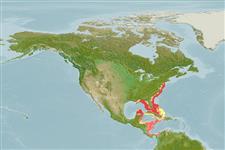>
Ophidiiformes (Cusk eels) >
Ophidiidae (Cusk-eels) > Ophidiinae
Etymology: Lepophidium: Latin, lepus, leporis = rabbit + Greek, ophis = serpent (Ref. 45335).
More on author: Gill.
Issue
Most references to L. profundorum between 1950 and 1986 apply to L. brevibarbe.
Environment: milieu / climate zone / depth range / distribution range
ນິເວດວິທະຍາ
ສັດທະເລ ອາໄສຢູ່ໃກ້ໜ້າດິນໃຕ້ພື້ນທ້ອງນ້ຳ; ລະດັບຄວາມເລິກ 29 - 399 m (Ref. 91765), usually 60 - 399 m (Ref. 91765). Tropical; 46°N - 21°S, 90°W - 73°W (Ref. 91765)
Western Atlantic: Georges Bank, Canada to the Florida Keys and the northern and eastern Gulf of Mexico.
ຂະໜາດ / ນ້ຳໜັກ / Age
Maturity: Lm ? range ? - ? cm
Max length : 28.0 cm TL ຕົວຜູ້/ບໍ່ມີເພດ; (Ref. 49746); common length : 22.0 cm TL ຕົວຜູ້/ບໍ່ມີເພດ; (Ref. 5217)
Short description
ຕົວທີ່ໃຊ້ໃນການຈຳແນກຊະນິດ | ສະລີລະວິທະຍາ | ການວັດແທກຮູບຮ່າງລັກສະນະພາຍນອກຂອງດິນ,ສັດ,ປາ…
ຄີ (ໜາມ)ແຂງຢູ່ຫຼັງປາ (ທັງໝົດ) : 0; ຄີຫຼັງຂອງປາ (ຄີອ່ອນ) (ທັງໝົດ) : 129 - 142; ຄີ(ໜາມ) ແຂງຢູ່ຄີກົ້ນປາ
ກຸ່ມປາກະດູກແຂງ
ຄວາມຖີ່ຂອງກຸ່ມຖ່າຍທອດພັນ
ປາທີ່ມີການເຄື່ອນຍ້າຍຈາກທະເລໄປຫານ້ຳຈືດ ແລະນ້ຳຈືດຫາທະເລ
ປາທີ່ມີການເຄື່ອນຍ້າຍຈາກທະເລແລະໄປໄຂ່ຢູ່ນ້ຳຈືດ
ຄີກົ້ນຂອງປາ
ສັດທີ່ມີກະດູກສັນຫັຼງ
ການຖ່າຍທອດທາງກຳມະພັນຈາກພໍ່ແມ່ຫາລູກ: 0; ຄີກົ້ນຂອງປາ: 109 - 121; ສັດທີ່ມີກະດູກສັນຫຼັງ: 73 - 78. This species possess the following characters: usually with 15 precaudal, 58-59 caudal, and 74-76 total vertebral counts; number of fin rays usually in dorsal 131-137, anal 112-117, pectoral 21-23; pyloric caeca 3 (2-4) in tiers of 2-3 caeca in the first and one in the second; total gill rakers on first arch 9-11 (8-13). Colour of head and body tan to brown, belly whitish; a conspicuous and diagnostic series of 14-23 pale spots, which are slightly smaller than the eye but larger than the pupil, extending from just behind the opercle to the caudal-fin base; a second series of smaller pale spots running along the anterior part of the body just below the dorsal-fin base (spots largely disappear in old museum specimens); dorsal and anal fins dark-edged posteriorly; gill chamber, gill bars, esophagus and the roof of the mouth behind the vomer and between the palatines blackish; stomach and hindgut unpigmented (Ref. 91765).
Uncommon species (Ref. 34024). Oviparous, with oval pelagic eggs floating in a gelatinous mass (Ref. 205).
Life cycle and mating behavior
Maturities | ການສືບພັນ | Spawnings | Egg(s) | Fecundities | ຕົວອ່ອນ
Robins, C.R., R.H. Robins and M.E. Brown, 2012. A revision of Lepophidium (Teleoastei, Ophidiidae), with descriptions of eight new species. Bulletin of the Florida Museum of Natural History 52(1):1-94. (Ref. 91765)
IUCN Red List Status (Ref. 130435)
Warning: mysqli::__construct(): (HY000/1040): Too many connections in /var/www/html/includes/func_getlabel.php on line 46
Can't connect to MySQL database (fbapp). Errorcode: Too many connections
